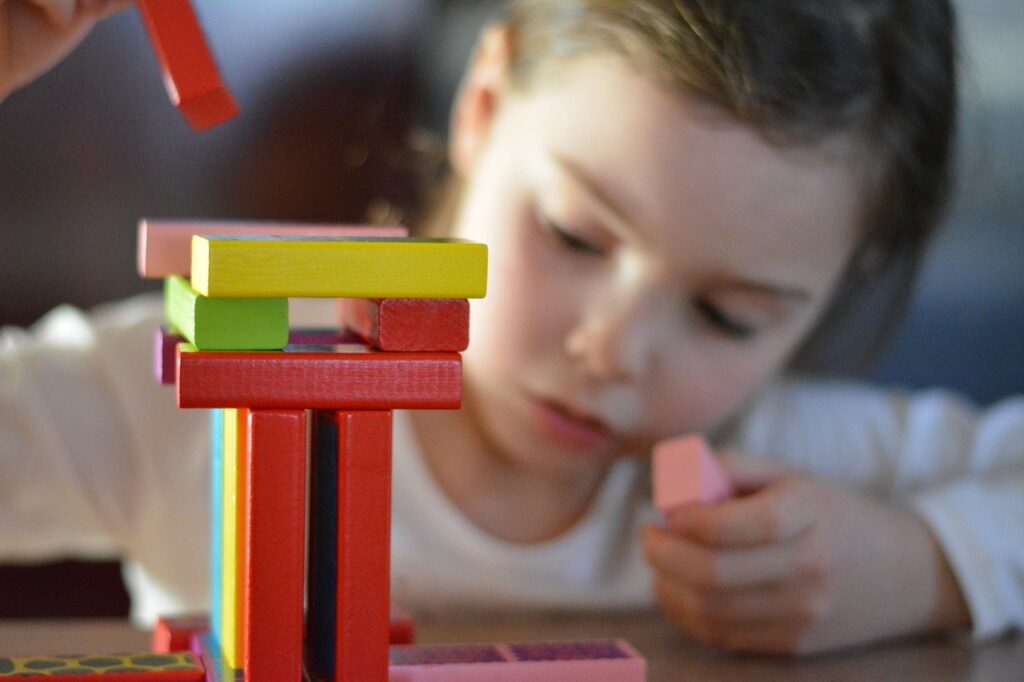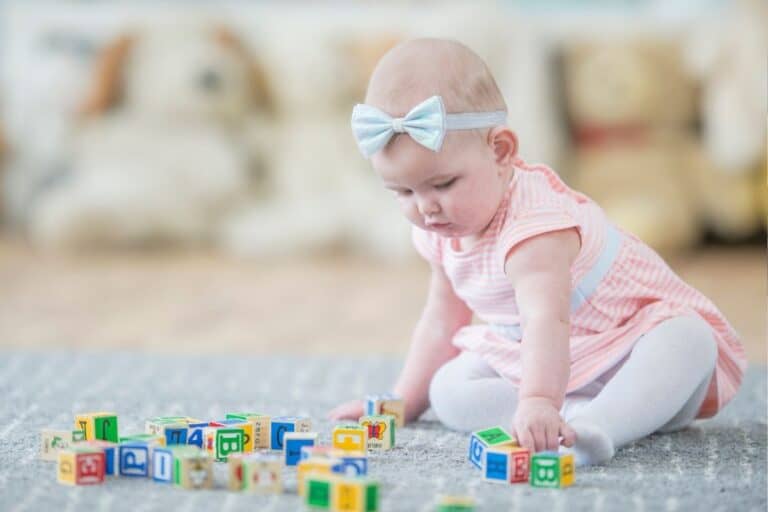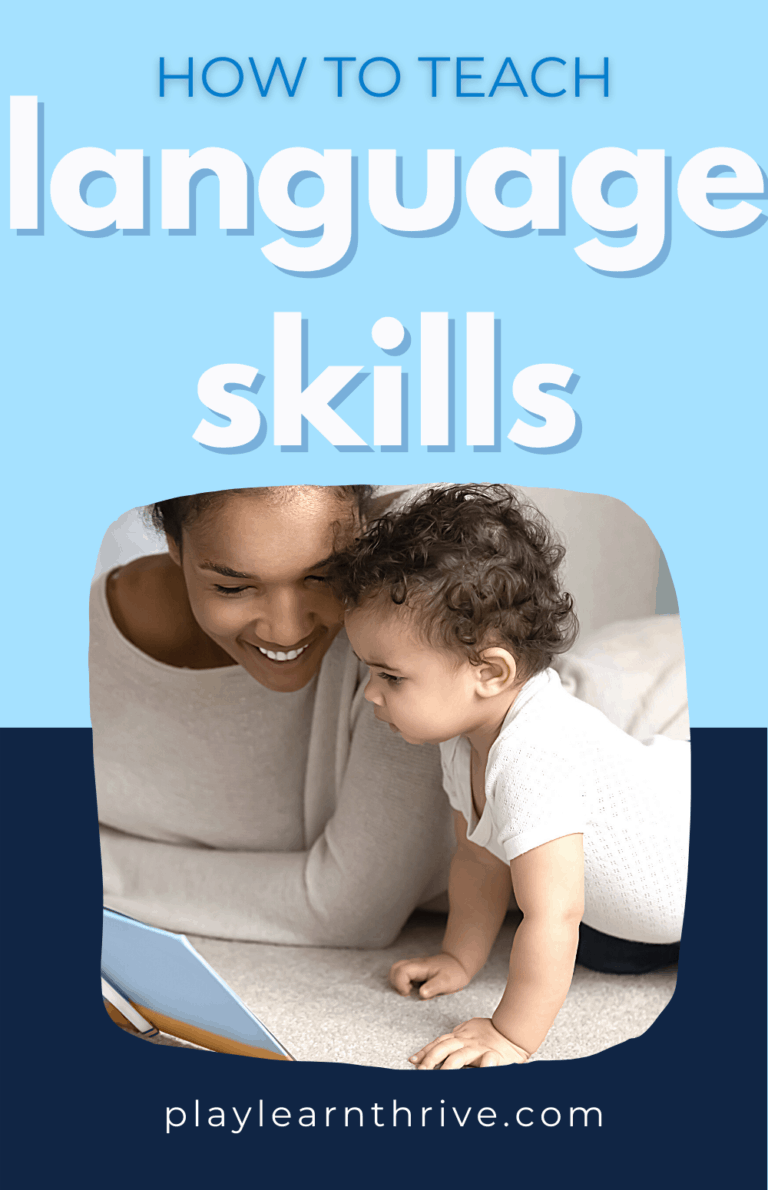What are the stages of play? Jean Piaget’s Theory of Play!
How can a theory published in 1936 still help you to understand your children and how to encourage them through their cognitive development?
Play. Learn. Thrive.™ only endorses products we authentically love and use. Some of the product links in this post may be affiliate links. That means that if you click them and make a purchase, this site makes a commission. Play. Learn. Thrive.™ is also an Amazon Associate. As an Amazon Associate, we earn from qualifying purchases. It will have no impact on the price you pay or the experience of your purchase.
While Jean Piaget’s Theory of Play is closing in on its one-hundredth anniversary, it is still used in education and psychology to understand the stages of children’s development.
And I can help you to understand your child's development so that you can support their play in a way that helps them grow.

What Is Play?
When you think of play, you probably think of a boy pushing cars or a girl digging in the sand, but what is play really?
Play is any activity this is not required that you do just for your self-enjoyment. The reward with play is the play itself. So anything you do for fun.
Why Is Play Important?
“Play is the work of childhood.”
That’s the famous quote, but who said it? That's right, Jean Piaget.
I know you might've thought it was Mr. Rogers. Mr. Rogers said, “ Play is often talked about as if it were a relief from serious learning. But for children, play is serious learning.”
Wait, didn't Maria Montessori say something like that?
She sure did. She said, “ Play is the work of the child.”
I could give you many more examples of famous child psychologists and education experts saying the child's work is play.
Because play is that important. Unfortunately, in today's society and lifestyles, there is not enough time for children to play.
Play is important to promote healthy child development. It is so important that the United Nations has recognized that play is the basic human right of every child.
Play helps children develop in their brains' cognitive, social, physical, and emotional areas.
Play allows children to use their creativity and imagination to strengthen their physical bodies and brain.
During play, children get to take on roles of adults like playing family or playing restaurant. They also get to conquer their fears and deal with any difficulties they are facing in their life.
It also helps them to build problem-solving skills and develop resiliency that will help them well into their adult life.
How Much Should Children Play?
In today's world, it often feels like there's no time for downtime for anyone, including children.
Between parents working, after-school activities, and homework finding time for children to have some downtime can feel like an impossible juggling act.
Some studies suggest that children should get 3 hours a day of outdoor play. But children should get regular play throughout their day, not just in one long session.

Piaget's Stages of Play: How Piaget Developed the Theory
At the beginning of his career, Jean Piaget was developing questions for a French version of the English intelligence test. He became fascinated with why children gave the wrong answers to the questions and what their logic was behind it.
He started thinking that these answers showcased the difference between adult thinking and child thinking. During his time, children were more viewed as small adults, so the idea that children and adults thought differently was revolutionary.
Once he had his children, he started making observations of how they grew and how they played.
Piaget developed his theory using his observations of his children and developed a theory of cognitive development that focused on the stages of play that children go through.

The Stages of Cognitive Development are found in Jean Piaget’s research.
Piaget’s research led him to build his theory on four stages of cognitive development based on how children play, including the sensorimotor stage, the pre-operational stage, the concrete operational stage, and the formal operational stage.
The stages are broken down by age from birth to 2 years, 2 to 7 years, and 7 to 11 years at 11 through adult.
1. The sensorimotor stage (birth to 2 years)
The sensorimotor stage of Jean Piaget's theory spans from birth to 2 years. during this stage, children learn through their five senses and movement and exploring their environment.
A good way to encourage development during this time is by giving children sensory play with sensory bins with different textures and playing with different activities that make different sounds.
It is important to provide children with a rich environment full of objects they can interact with that incorporate all of their senses.
Things you can give your child:
- Different textures and fabrics: Corduroy, velvet, denim, papers, sandpaper, and bubble wrap
- Things that make different sounds: whistles, bells. toys that click
- Things of different shapes and sizes: foam blocks with a variety of shapes
- A space that encourages movement: Pikler triangle, baby gyms, and tummy time mats
2. The preoperational stage (2 to 7 years)
The preoperational stage of Jean Piaget's theory spans from 2 to 7 years.
This stage begins when your child starts talking and communicating more, but they are still unable to put ideas together logically. During this time, children start doing parallel play which means that they're playing next to children but not really with them.
Also, during this stage, children have difficulty seeing things from other people’s points of view. Children start playing more pretend games and role-playing games.
In this stage, it is important that your child continue to learn through real-world experiences but is also given the opportunity for pretend play.
Things that will help your child through the preoperational stage :
- Dolls including lottie dolls, Peg dolls, and baby dolls
- Action figures
- Dress-up clothes
- Small world toys ( items to build their small worlds, including animal figurines, dolls, dollhouses, and furniture)
- Building blocks and construction set
- Crayons, markers, pens, pencils, and paper to draw with
- Picture books and some board books while they are still young toddlers

3. The concrete operational stage (7 to 11 years)
The concrete operational stage lasts between the ages of 7 years old and 11 years old, according to Jean Piaget's theory.
Your child will start building logical thought and be able to understand the laws of conservation, where the same thing can be different shapes and be the same amount. For example, they will be able to understand a cup of water is the same amount if it's in a tall thin glass or a short, stout glass.
At this age, children become expert problem solvers and want to understand how the world works around them.
Things you can give your child to help them develop during the concrete operational stage:
- Logic games like Mancala and chess
- STEM toys (mechanical building sets)
- Science kits
- Hobbies that create something like woodworking or sewing or crocheting
- Number games
- Models to build ( airplane models, doll houses, and car models)
- Legos and Lego sets
4. The formal operational stage (11 to adult)
The formal operational stage Jean Piaget's theory from around 11 or 12 years old through adulthood.
During the formal operational stage, children and adolescents begin to understand abstract thought and can manipulate ideas in their heads.
They will also be able to do more complicated math and think creatively, and they can understand more complicated scientific ideas. They also can understand hypothetical scenarios and questions.
Things to help your child develop during the formal operational stage:
- Rubik’s cubes
- Chess
- Games that involve strategy and thought
- Sudoku puzzles
- A multitude of books on different subjects
- Also, taking classes on hobbies and deep-diving into hobbies
What are the key elements of Piaget's theory?
Piaget’s theory consists of the four stages of cognitive development that always happen in the same order, are never skipped, and slowly transition into the next stage.
The stages are:
- The sensorimotor stage (0-2 years old)
- The preoperational stage (2-7 years old)
- The concrete operational stage (7-11 years old)
- The formal operational stage (11-adulthood)
What is schema, according to Piaget?
Frederic Bartlett was the first to use the idea of schemas in his theory on learning, but it was Piaget who would first use the term schema.
For Piaget, a schema is a process of learning new knowledge and the category to which knowledge belongs. He believed that schemas were constantly evolving as people took in new knowledge.
According to Piaget, a common example of a schema would be a child’s understanding of a dog. To a small child, a dog has fur, four legs, teeth, and a tail; when she sees a cat, she may also call it a dog because it checks all the same boxes.
It’s not uncommon for small children to call all animals they encounter a puppy. As they are corrected and learn more about different animals, their idea of what a puppy is changing to be a more specific definition.

Piaget's four types of play & What they mean for a child’s development
According to Piaget, children play in 4 ways, functional, constructive, fantasy, and games with rules. These types of play occur at different stages of development.
Piaget believed that the way children play shows their cognitive development level.
Functional play
Functional play is more physical, like running, sliding, jumping, dumping out a box of toys, and experimenting with the world through their senses.
This type of play is prevalent during the sensorimotor stage between 0-2. This stage of play ends between the ages of 2 and 4.
From here, children will move from just moving blocks around and tossing them to stacking them and starting constructive play.
Constructive play
During this play stage, children want to play with toys and other objects to accomplish a goal. For example, using blocks to build a tower.
Children tend to play this way between the ages of 3-7. Eventually, they will start mixing in some fantasy play with their constructive play.
Instead of building a tower, they might use blocks to build a little town and drive cars around their block buildings on imaginary roadways.
Symbolic/fantasy play
During the fantasy or symbolic stage of play. Children play make-believe games and role-playing games.
These games can be fantasy-themed like princesses and knights or role-playing games like a teacher, police officer, or mom and dad.
The best way to support and encourage your child during this play stage is to give them dress-up clothes and play pretend with them. Often they will want to tell you what to do during the game.
This stage can start around 3-4 years of age and last through 11 or 12 years old.
Games with rules
The last stage of play is games with rules. During this type of play, children play games with friends with preset rules like tag or hide and seek.
This can also include board games and video games.
During this stage, children understand how to follow the rules, and if someone breaks the rules, there are consequences in the game. They understand ideas like cooperation and like being competitive.
These games usually begin around the age of 7 and continue through adulthood.
Conclusion: Piaget's theory of play and its respective stages is something to consider when choosing toys for your child.
When choosing toys for your child, you want to consider the stage of development they are in and the kind of play they do in that stage.
For example, you wouldn't buy a board game for an 18-month-old, but playing it with your 7-year-old could be fun for both of you.
You want to choose the toys that best help your child develop in their stage.
You can learn more about my recommendations on toys here in my gift guides, which are based on cognitive development and theories of play.

References:







